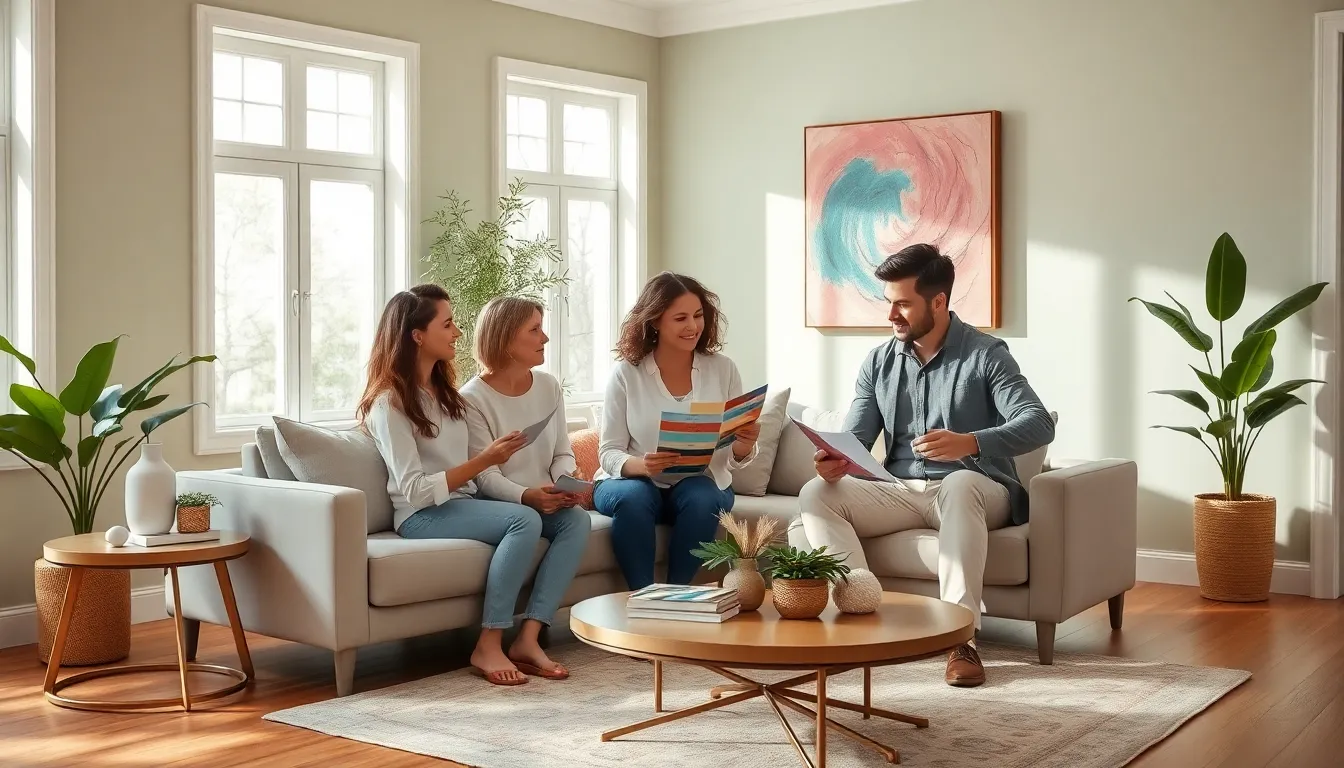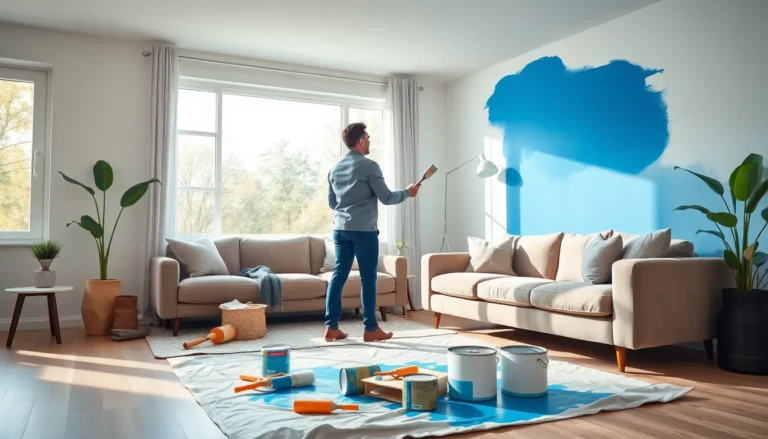When it comes to transforming a space, few things are as impactful as a fresh coat of paint. Painting interiors can turn a dreary room into a vibrant haven, all while showcasing personal style. But before wielding that roller like a micro-Reno Picasso, it’s crucial to navigate the swatches, finishes, and techniques. This comprehensive guide simplifies the painting process, turning what could be a challenging job into an enjoyable and artistic try. Get ready to jump into the colorful world of interior painting.
Table of Contents
ToggleChoosing the Right Paint Colors

Factors to Consider When Selecting Colors
Choosing a paint color is not just about what looks pretty. It’s an art that considers numerous elements. First, think about the room’s purpose. A calming blue may work wonders in a bedroom, while a vibrant yellow could suit a lively kitchen. Natural light also plays a significant role. South-facing rooms bask in warm sunlight, so cooler colors can balance this warmth. Conversely, north-facing spaces benefit from warmer hues to counteract the coolness. Also, consider the home’s overall color palette. Colors should harmonize with existing decor and furnishings to create a cohesive look.
Popular Color Trends for Interiors
Current trends frequently shift, but certain colors have become staples, reflecting societal moods and preferences. Soft, muted tones like sage green and blush pink are beloved for their calming effects. Meanwhile, rich jewel tones such as emerald and sapphire offer a bold, dramatic flair. Neutrals, think greys, beiges, and whites, remain ever-popular due to their versatility, adapting smoothly to any decor style. Explore these shades and find what resonates most with your vision for your space.
Understanding Paint Finishes
Types of Paint Finishes Explained
Not all paint finishes are created equal, and understanding the options is key to achieving the desired effect. The most common finishes include:
- Flat: Ideal for low-traffic areas, it provides a matte look that conceals imperfections but isn’t durable against cleaning.
- Eggshell: A slight sheen makes eggshell finishes more wash-friendly, suitable for living rooms and bedrooms.
- Satin: This is a go-to for areas needing some durability, like hallways and kitchens, as it withstands scrubbing without losing its luster.
- Semi-Gloss: Often used in bathrooms and kitchens, it reflects light brilliantly and is excellent for doors and trim.
- Gloss: High shine adds a bold contrast, best for highlighting architectural features, though it shows imperfections more prominently.
Choosing the Right Finish for Each Room
Selecting the finish goes beyond just aesthetic preferences. Consider the room’s functionality and maintenance. For high-traffic areas, satin or semi-gloss ensures longevity and easy cleaning. Conversely, for ceilings and low-traffic areas, flat finishes are budget-friendly and understated.
Preparing Your Space for Painting
Essential Preparation Steps
Preparation is half the battle won when painting. Start by removing furniture or covering it with drop cloths to protect it from accidental splashes. Next, clean the walls to eliminate any dust or grease, ensuring better adhesion. Filling in cracks and holes with spackle also contributes to a smooth finish. Finally, tiring but crucial, tape off edges where walls meet ceilings, and moldings align, this prevents overlap for a clean line.
Tools and Materials You Will Need
Arming yourself with the right tools is vital. Here’s a quick checklist:
- Paint rollers and trays (or brushes for detailing)
- Painter’s tape for crisp lines
- Drop cloths to catch drips
- Sandpaper to smooth surfaces
- A ladder for those hard-to-reach spots
Each tool serves to make the job easier and the results cleaner.
Techniques for Painting Interiors
Basic Painting Techniques for Beginners
Kick off with the basics. When applying paint, start with an edge brush to coat corners and tight areas. Use a roller for larger wall spaces. Load the roller with paint, but avoid oversaturating it. Apply in a W or M pattern, then fill in the gaps. This approach ensures even coverage without streaks. Don’t forget to paint in thin layers, multiple light coats often yield a smoother finish than one heavy application.
Advanced Techniques for a Professional Finish
For those daring enough to elevate their skills, consider exploring advanced techniques. Techniques like sponging or rag rolling can add interesting textures. Also, learn the art of creating an ombre effect by mixing two shades of the same hue. These tricks require practice but yield stunning, journal-worthy results.
Maintaining Your Painted Interiors
Tips for Keeping Walls Fresh and Clean
Once those walls are painted, ongoing maintenance is essential. Regular dusting keeps walls looking crisp, while gentle cleaning with a damp cloth helps remove stains without damaging the finish. Avoid harsh chemicals, these can strip the paint or dull its shine. For flat finishes, cleaning may be minimal to preserve that matte effect, but eggshell and satin can handle a more rigorous scrubbing.
When to Touch Up or Repaint
Even with the best care, wear and tear is inevitable. Look for signs like fading or chipping, which indicate it’s time for a touch-up. Ideally, repaint every five to seven years, but this varies based on room use, wear, and individual preferences. Keeping leftover paint from the original job makes touch-ups easier and ensures color consistency.






